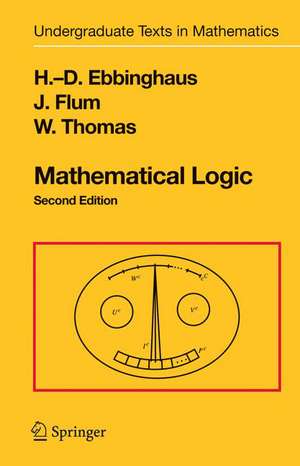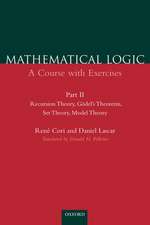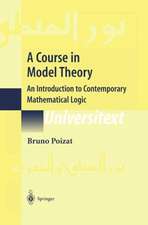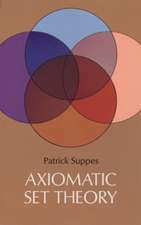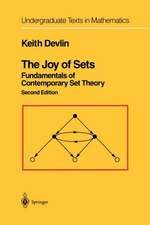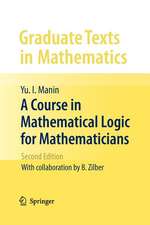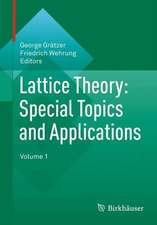Mathematical Logic: Undergraduate Texts in Mathematics
Autor H.-D. Ebbinghaus, J. Flum, Wolfgang Thomasen Limba Engleză Hardback – 10 iun 1994
| Toate formatele și edițiile | Preț | Express |
|---|---|---|
| Paperback (1) | 425.52 lei 39-44 zile | |
| Springer – 11 dec 2012 | 425.52 lei 39-44 zile | |
| Hardback (1) | 477.05 lei 6-8 săpt. | |
| Springer – 10 iun 1994 | 477.05 lei 6-8 săpt. |
Din seria Undergraduate Texts in Mathematics
- 17%
 Preț: 362.13 lei
Preț: 362.13 lei - 17%
 Preț: 365.42 lei
Preț: 365.42 lei - 20%
 Preț: 466.83 lei
Preț: 466.83 lei -
 Preț: 358.10 lei
Preț: 358.10 lei -
 Preț: 351.54 lei
Preț: 351.54 lei -
 Preț: 440.01 lei
Preț: 440.01 lei -
 Preț: 304.91 lei
Preț: 304.91 lei -
 Preț: 257.71 lei
Preț: 257.71 lei -
 Preț: 380.26 lei
Preț: 380.26 lei -
 Preț: 400.42 lei
Preț: 400.42 lei - 17%
 Preț: 373.59 lei
Preț: 373.59 lei -
 Preț: 372.26 lei
Preț: 372.26 lei -
 Preț: 339.36 lei
Preț: 339.36 lei - 17%
 Preț: 368.60 lei
Preț: 368.60 lei -
 Preț: 400.42 lei
Preț: 400.42 lei - 17%
 Preț: 366.38 lei
Preț: 366.38 lei -
 Preț: 290.80 lei
Preț: 290.80 lei - 15%
 Preț: 417.73 lei
Preț: 417.73 lei - 17%
 Preț: 395.93 lei
Preț: 395.93 lei -
 Preț: 407.96 lei
Preț: 407.96 lei -
 Preț: 298.00 lei
Preț: 298.00 lei -
 Preț: 359.48 lei
Preț: 359.48 lei -
 Preț: 415.94 lei
Preț: 415.94 lei -
 Preț: 280.65 lei
Preț: 280.65 lei -
 Preț: 407.62 lei
Preț: 407.62 lei -
 Preț: 370.77 lei
Preț: 370.77 lei -
 Preț: 395.09 lei
Preț: 395.09 lei - 17%
 Preț: 367.24 lei
Preț: 367.24 lei -
 Preț: 402.33 lei
Preț: 402.33 lei -
 Preț: 364.40 lei
Preț: 364.40 lei -
 Preț: 332.02 lei
Preț: 332.02 lei - 13%
 Preț: 389.61 lei
Preț: 389.61 lei -
 Preț: 433.85 lei
Preț: 433.85 lei -
 Preț: 424.14 lei
Preț: 424.14 lei - 17%
 Preț: 362.67 lei
Preț: 362.67 lei - 19%
 Preț: 400.52 lei
Preț: 400.52 lei -
 Preț: 329.94 lei
Preț: 329.94 lei - 19%
 Preț: 492.82 lei
Preț: 492.82 lei -
 Preț: 396.24 lei
Preț: 396.24 lei -
 Preț: 390.08 lei
Preț: 390.08 lei - 15%
 Preț: 521.04 lei
Preț: 521.04 lei -
 Preț: 402.00 lei
Preț: 402.00 lei - 15%
 Preț: 531.72 lei
Preț: 531.72 lei - 15%
 Preț: 447.81 lei
Preț: 447.81 lei - 15%
 Preț: 533.53 lei
Preț: 533.53 lei
Preț: 477.05 lei
Preț vechi: 561.24 lei
-15% Nou
Puncte Express: 716
Preț estimativ în valută:
91.28€ • 95.50$ • 75.83£
91.28€ • 95.50$ • 75.83£
Carte tipărită la comandă
Livrare economică 03-17 aprilie
Preluare comenzi: 021 569.72.76
Specificații
ISBN-13: 9780387942582
ISBN-10: 0387942580
Pagini: 291
Ilustrații: X, 291 p.
Dimensiuni: 155 x 235 x 25 mm
Greutate: 0.59 kg
Ediția:2nd ed. 1994
Editura: Springer
Colecția Springer
Seria Undergraduate Texts in Mathematics
Locul publicării:New York, NY, United States
ISBN-10: 0387942580
Pagini: 291
Ilustrații: X, 291 p.
Dimensiuni: 155 x 235 x 25 mm
Greutate: 0.59 kg
Ediția:2nd ed. 1994
Editura: Springer
Colecția Springer
Seria Undergraduate Texts in Mathematics
Locul publicării:New York, NY, United States
Public țintă
Lower undergraduateCuprins
A.- I Introduction.- II Syntax of First-Order Languages.- III Semantics of First-Order Languages.- IV A Sequent Calculus.- V The Completeness Theorem.- VI The Löwenheim-Skolem and the Compactness Theorem.- VII The Scope of First-Order Logic.- VIII Syntactic Interpretations and Normal Forms.- B.- IX Extensions of First-Order Logic.- X Limitations of the Formal Method.- XI Free Models and Logic Programming.- XII An Algebraic Characterization of Elementary Equivalence.- XIII Lindström’s Theorems.- References.- Symbol Index.
Recenzii
“…the book remains my text of choice for this type of material, and I highly recommend it to anyone teaching a first logic course at this level.” – Journal of Symbolic Logic
Descriere
Descriere de la o altă ediție sau format:
What is a mathematical proof? How can proofs be justified? Are there limitations to provability? To what extent can machines carry out mathe matical proofs? Only in this century has there been success in obtaining substantial and satisfactory answers. The present book contains a systematic discussion of these results. The investigations are centered around first-order logic. Our first goal is Godel's completeness theorem, which shows that the con sequence relation coincides with formal provability: By means of a calcu lus consisting of simple formal inference rules, one can obtain all conse quences of a given axiom system (and in particular, imitate all mathemat ical proofs). A short digression into model theory will help us to analyze the expres sive power of the first-order language, and it will turn out that there are certain deficiencies. For example, the first-order language does not allow the formulation of an adequate axiom system for arithmetic or analysis. On the other hand, this difficulty can be overcome--even in the framework of first-order logic-by developing mathematics in set-theoretic terms. We explain the prerequisites from set theory necessary for this purpose and then treat the subtle relation between logic and set theory in a thorough manner.
What is a mathematical proof? How can proofs be justified? Are there limitations to provability? To what extent can machines carry out mathe matical proofs? Only in this century has there been success in obtaining substantial and satisfactory answers. The present book contains a systematic discussion of these results. The investigations are centered around first-order logic. Our first goal is Godel's completeness theorem, which shows that the con sequence relation coincides with formal provability: By means of a calcu lus consisting of simple formal inference rules, one can obtain all conse quences of a given axiom system (and in particular, imitate all mathemat ical proofs). A short digression into model theory will help us to analyze the expres sive power of the first-order language, and it will turn out that there are certain deficiencies. For example, the first-order language does not allow the formulation of an adequate axiom system for arithmetic or analysis. On the other hand, this difficulty can be overcome--even in the framework of first-order logic-by developing mathematics in set-theoretic terms. We explain the prerequisites from set theory necessary for this purpose and then treat the subtle relation between logic and set theory in a thorough manner.
